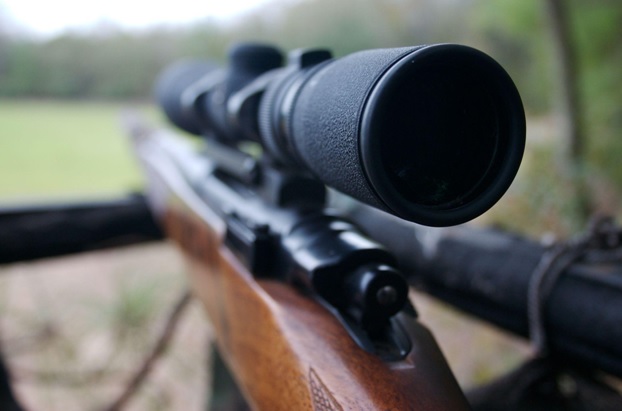High-quality ammo designed for long-range shooting, like Federal’s Gold Medal Match ammo, is not cheap. You’ll want to make every shot count, whether you’re scoring in competition or not.
We could fill up a whole book with tips and suggestions for long-range shooting, but in this article, we’re just going to focus on a couple.
Here are three critical suggestions for long-range shooting.
Be Aware of Parallax Distortion
Parallax distortion is an optical phenomenon that occurs when you look through a lens at an angle. If you’re not looking dead-on, the image through the lens will shift.
It doesn’t matter if you’re looking in from the side at an angle, or if your eye is too low. Parallax distortion can occur regardless of the orientation at which you start.
The issue here is that, when you look through an optic like a scope and experience parallax distortion, what you’re seeing through the lens is not a true representation of where the target actually is.
Or, rather, what you’re seeing is not a faithful indication of how the rifle is oriented with respect to point of aim.
To be clear, when you have a parallax distortion, the reticle will cover a point of impact on the target that is not aligned with the calibration of the gun.
Now here’s the thing. At intermediate ranges, this usually isn’t a massive concern. A minor parallax distortion won’t usually cause a wide miss when you’re shooting at a target that’s pretty close.
But when you up the ante and your target is 500 or even 1000 yards away, or further, that paradigm changes. A very, very insignificant parallax distortion can cause a severely wide miss of the target - entirely - at ranges in excess of 500 yards.
This reason alone makes it critical that you ensure you’re aiming properly, meaning that your eye is level, eye relief is appropriate, and that you aren’t torqued off to one side or the other. It can be very hard to tell whether or not you’re experiencing a parallax distortion, until you shoot - and then it’s too late.
Be Conscious About Breath Control
Breath control and breathing discipline can also impact how accurately you shoot, especially at long ranges.
Whether you notice it or not, your breathing can (and does) impart undesired motion to the rifle. You might notice this as the reticle bouncing around a little, or you might not notice it at all, but it is happening.
Some long-range shooters will tell you to hold your breath before pulling the trigger. If you do, you have to shoot within a few seconds, as your vision will start to dim when oxygen levels in your blood get depleted.
Others will tell you to shoot at the natural low of your breathing cycle - after you exhale, but before you take your next breath. This is a good suggestion, too.
Either way, being aware that each breath you take can impact your point of aim is critical. It’s also important to recognize that even your heartbeat imparts undesired motion to the rifle.
This is one of the reasons that biathlon shooting is so difficult; rapid breathing and a hard, fast heart rate make the reticle jump all over the place.
All in all, when long-range shooting, make sure you are calm, your heart rate is resting, and your breathing is as metered as possible - and one way or the other, shoot when you’re neither inhaling nor exhaling, whether you hold your breath or time the shot.
Relax Your Grip on the Rifle
Just like your breathing and your heartbeat can make the point of aim of a rifle bounce and shift, placing a load on the rifle can and will do the same thing.
Most often, this problem occurs when you have the rifle in a death grip. This is a condition that you absolutely want to avoid.
Gripping the rifle hard, or leaning heavily on or into the stock, places a load on the rifle that can shift the point of aim or worse, mess with the barrel harmonics.
The conventional wisdom here is actually the opposite of what applies to shooting a handgun. With a handgun, you want to hold high, tight, and lock your wrists and elbows. With a rifle, you want in theory not to be contacting the rifle at all.
Of course, this is not possible. But you don’t want a death grip on the grip or stock, and you don’t want to jerk the trigger.
Minimizing the forces you impart on the rifle will help preserve a faithful, uninterrupted point of aim and should help with accuracy, too.

Final Note: Shoot Quality Long-Range Ammo, like Federal’s Gold Medal Match
Did you find these tips helpful? Then the next thing you need to do is get some quality ammo designed for long-range shooting, like Federal’s Gold Medal Match OTM ammo. Designed for long-range stability and accuracy, high-quality ammo can help you shrink your groups at great ranges, especially when you’re cognizant of and employ the suggestions found in this article.
The last piece is practice. You won’t get better if you don’t put in the time at the range, so get to it.

